Why We’re So Obsessed With Historical Love Stories
When I was 13 and my sister was 11, we were obsessed with a book about Anne Boleyn that we discovered in our middle school library. This led to us being the youngest people by at least 50 years when we saw “The Other Boleyn Girl” in theaters together, a memory that still makes us laugh.
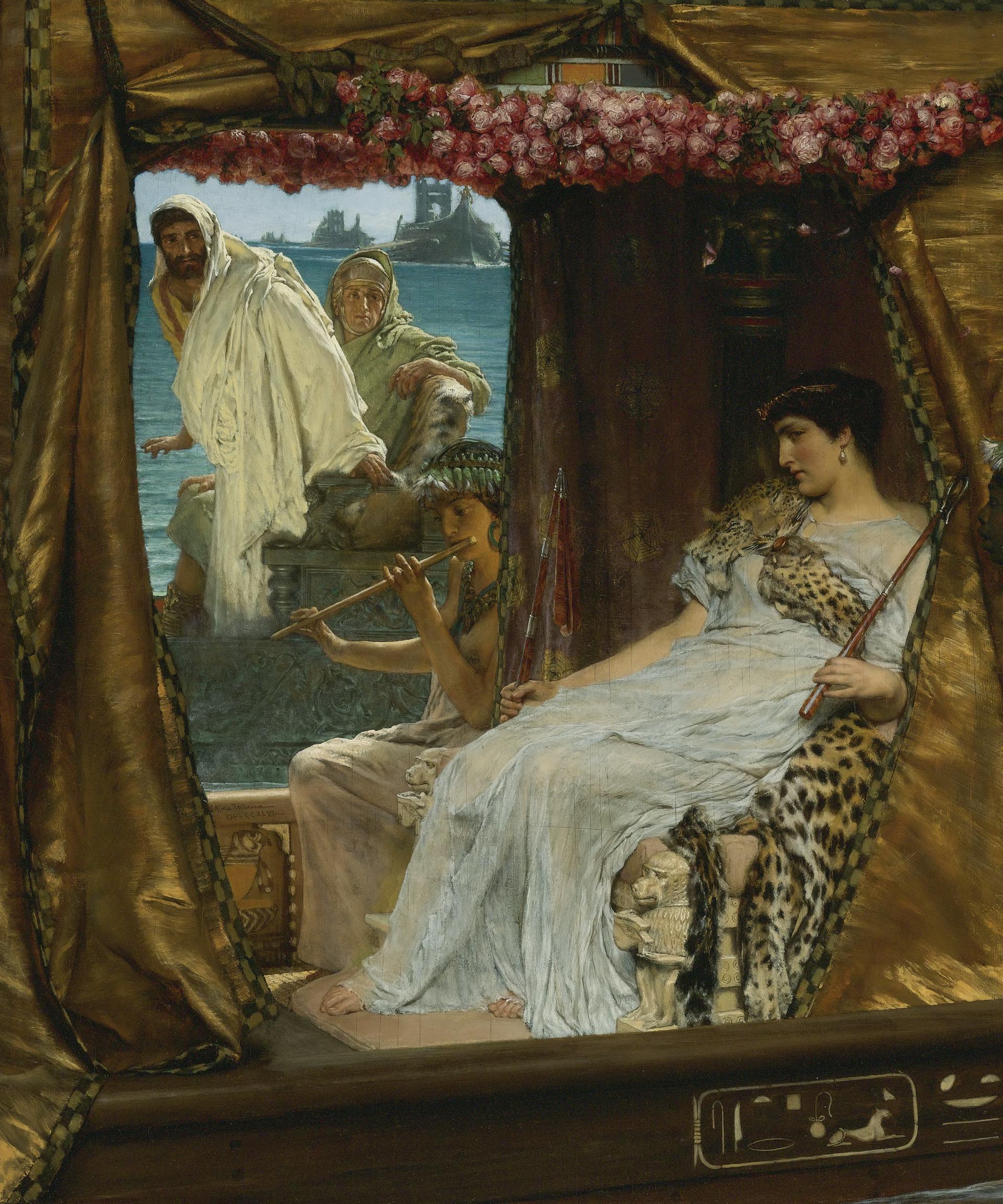
My love for historical romance stories led me to read Nicholas and Alexandra for the first time and to my Grandpa introducing me to Anna Karenina when I was 15. It also led to me bingeing The Tudors with my mom at 17 to cheer me up after my first heartbreak (the cure to a broken heart is lots of chocolate bars and Henry Cavill) and my fascination with Bonnie & Clyde when I was 19. A love for historical romance is something I share with many friends and members of my family, and we’re not the only ones.
The popularity of shows like The Spanish Princess and The Crown shows that our culture loves historical romance stories. This leads to the question as to why we enjoy these stories so much.
The Psychology Behind Our Love for Historical Romance
Whether it’s reading historical fiction novels or bingeing Downton Abbey, there’s a reason behind our love for historical love stories. Mary Balogh, a New York Times bestselling author of historical romance novels, says it best.
Balogh says, “Readers like to be transported away from their everyday lives. They like to be taken to a different world even if they also want to read about people who are essentially like themselves. Past eras often seem more romantic than our own. Regency England, for example, can conjure marvelous visual images of fashions for both men and women that were perhaps the most attractive and sexy of any age; of stately country homes and the spacious parks surrounding them; of horse-drawn carriages bowling along the king’s highway; of couples waltzing at grand balls in the light of dozens of candles in the crystal chandeliers overhead; of enchanted evenings strolling the lantern-lit walks of Vauxhall Gardens in London; of picnics and garden parties in rural surroundings; of drives in Hyde Park at the fashionable hour. The possibilities are endless, all coming with an aura of the romance of a bygone age.”
Meeting the love of your life at a ball in a beautiful gown sounds more romantic than at a bar or on a dating app.
Think about it. Meeting the love of your life at a ball in a beautiful gown sounds a lot more romantic than at a bar or on a dating app. But being fascinated by the romance of an era doesn’t mean we want to go back in time. Balogh continues, “It is a happy illusion, of course. Most of us would not want actually to live in Regency England or any other bygone era, but we are quite happy to enjoy it from the comfort of our 21st-century homes. That is the magic of reading.”
I’ve always been fascinated by the glamour of past eras and always get the “but you wouldn’t last a day without electricity” comment (apparently, the glamour and romance of a Jane Austen novel with modern electricity are too much to ask for, so just let me have my historical romance books, shows, and movies, Karen), but consuming media that describes the romance of a bygone era is the perfect way to get the best of both worlds.
It also helps that humans love fiction, making both fictional historical love stories and real ones so popular. Here are some of the most famous true love stories that have lasted through time.
The Five Most Famous True Love Stories
Antony and Cleopatra
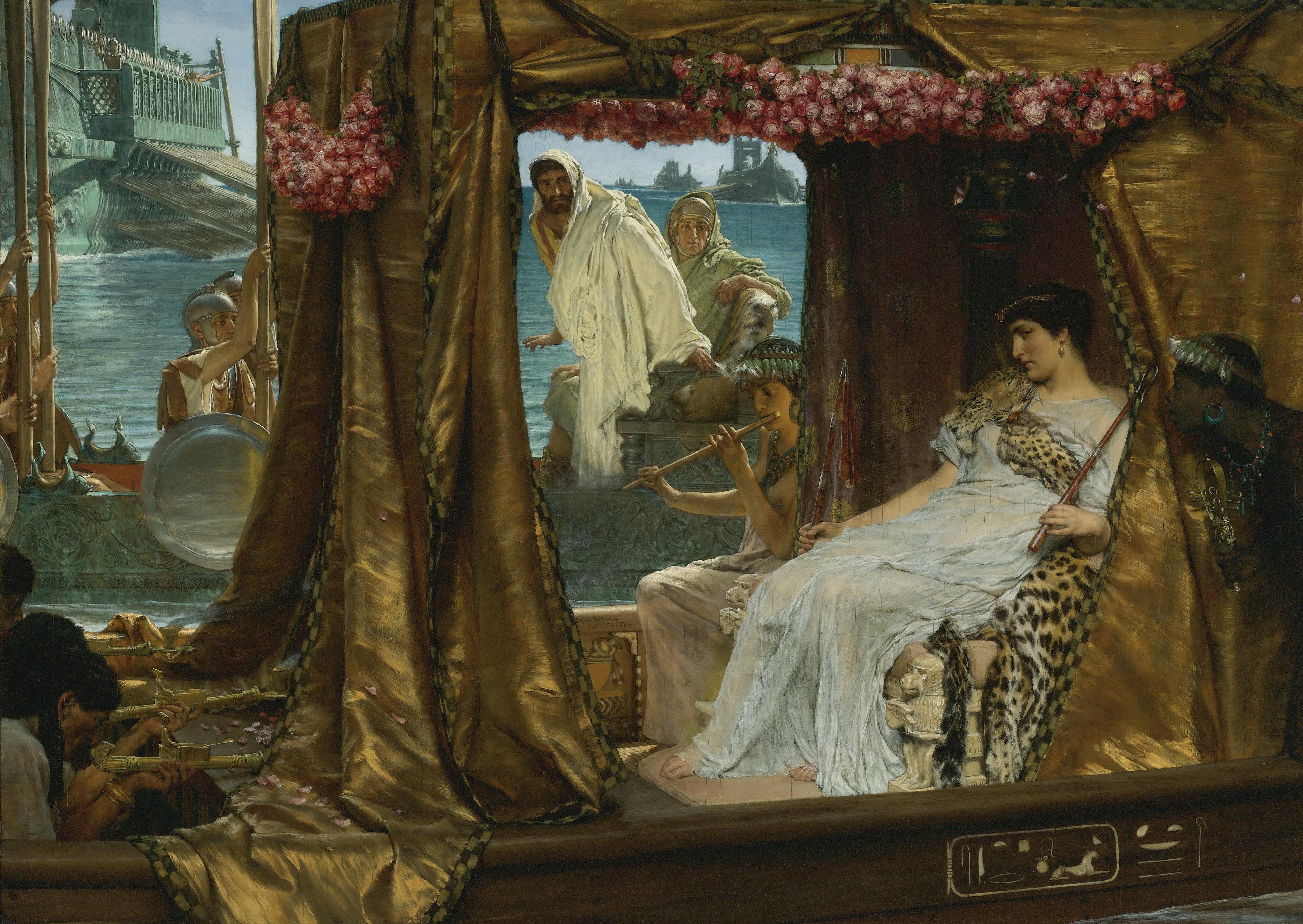
Public domain, via Wikimedia Commons.
A love story so powerful that it’s still beloved 2000 years after their death. She was the beautiful Queen of Egypt, and he was a Roman politician, described as “broad-shouldered, bull-necked, ridiculously handsome, with a thick head of curls and aquiline features.” The pair became close after the assassination of Julius Caesar in 44 BC, who was a friend of Antony’s and Cleopatra’s lover. Their mutual love of splendor and the finer things helped form a romantic relationship. Though they both needed each other to further their own political careers, it’s widely believed that they also sincerely loved each other.
Their bliss was cut short when Emperor Augustus (also known as Octavian) of Rome took away Antony’s power and declared war on Cleopatra. This led the pair to commit suicide in 30 BC. The most famous adaptations of this story are William Shakespeare’s tragedy Antony and Cleopatra and the 1963 film, Cleopatra, starring Elizabeth Taylor as Cleopatra and Richard Burton as Antony.
King Henry VIII and Anne Boleyn
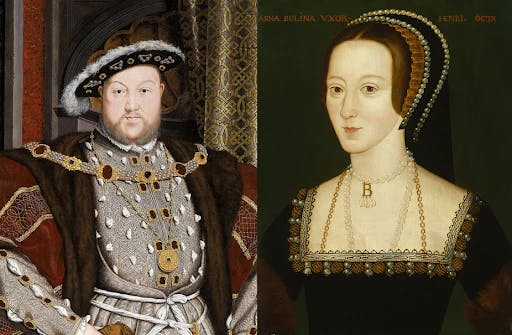
Public domain, via Wikimedia Commons.
When I first read about this in middle school, I couldn’t believe that this was a true story because it’s truly something out of a soap opera. Henry fell for Anne when she was a lady-in-waiting to his first wife, Catherine of Aragon. When Catherine’s devout Catholicism got in the way of Henry’s desire to divorce her, Henry created the Church of England to divorce Catherine and marry Anne. Their marriage didn’t end well as Henry had Anne executed in 1536, after she was found guilty of "adultery, incest, and conspiracy against the king."
Though there are many famous adaptations of their story, some of the most popular modern adaptations are Philippa Gregory’s 2001 novel The Other Boleyn Girl and the 2008 movie of the same name, as well as the first two seasons of The Tudors.
Shah Jahan and Mumtaz Muhal
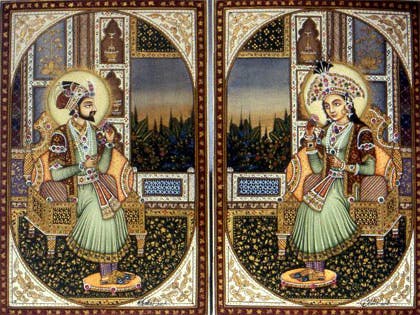
Via Wikimedia Commons.
Though many know the Taj Mahal as the beautiful mausoleum in Agra, India, some don’t know the love story behind it. After Mumtaz Mahal, the favorite wife of Mughal emperor Shah Jahan, died in 1631, Shah Jahan was devastated at the death of his beloved wife. Her dying wish was for Shah Jahan to build a monument dedicated to their love, and he did.
Relying on the Quran for a description of what Heaven looked like, Shah Jahan ordered a beautiful tomb to be built in her honor. He was so dedicated to creating the most beautiful tomb in the world that he made the artists behind the Taj Mahal promise him to never work again after it was finished, ensuring that they could never create something more beautiful. The Taj Mahal took 21 years to build and is the final resting place of both Mumtaz Mahal and Shah Jahan. It’s widely believed that their 19-year marriage was a happy and loving one, and the true reflection of it is seen in their mausoleum.
Though there aren’t any popular Western adaptations of this story (let’s be real, there should be), the greatest symbol of their love story is the popularity and beauty of the Taj Mahal itself.
Queen Victoria and Prince Albert
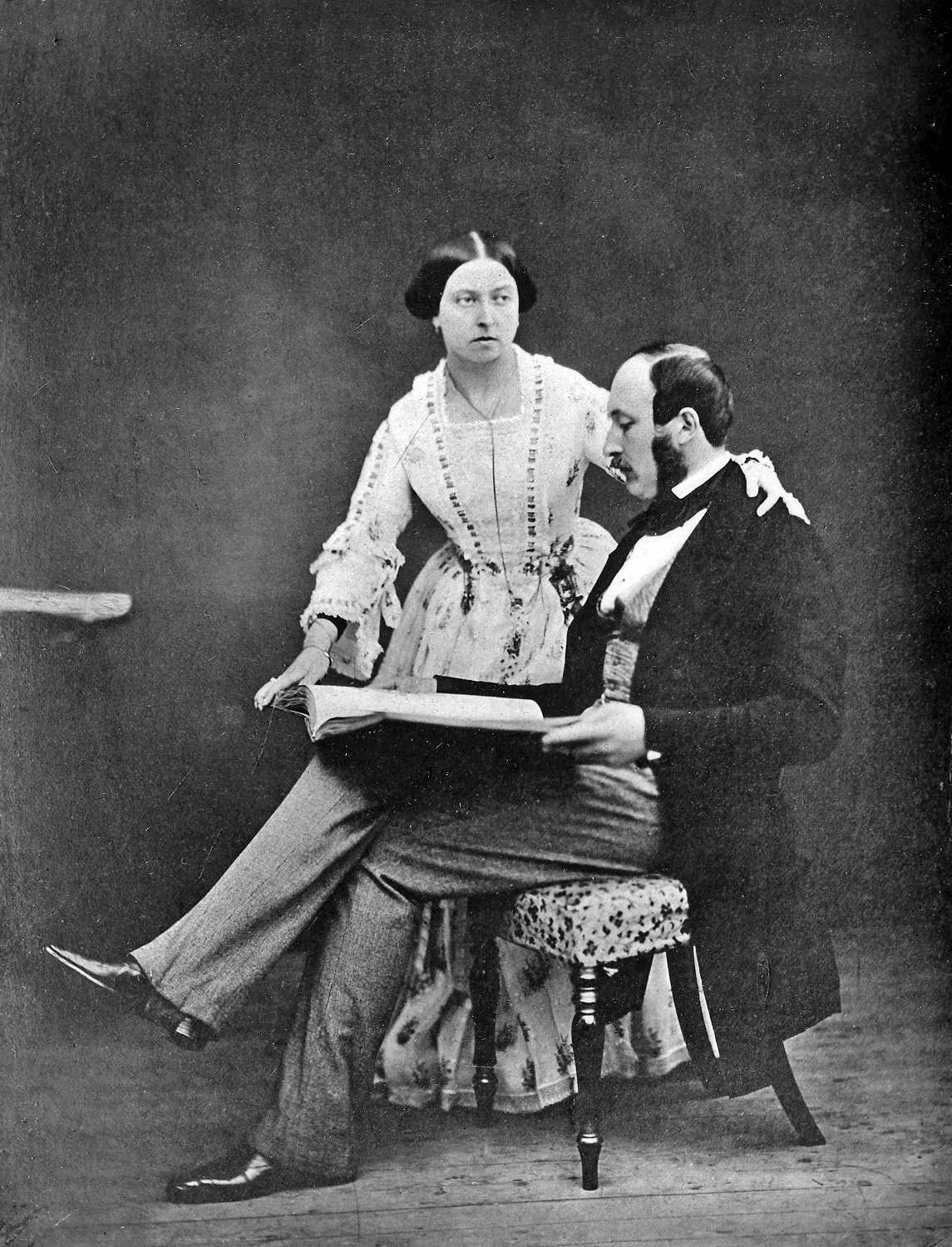
Public domain, via Wikimedia Commons.
Victoria and Albert’s love was so strong that it helped normalize marrying for love instead of for economic reasons. They married when they were both 20 years old in 1840, and their love lasted long after Albert died of typhoid fever in 1861. Victoria was devastated as she wrote in a letter to her eldest daughter, “How I, who leant on him for all and everything – without whom I did nothing, moved not a finger, arranged not a print or photograph, didn’t put on a gown or bonnet if he didn’t approve it, shall go on, to live, to move, to help myself in difficult moments?”
Though Victoria lived for another 40 years, she never fully recovered from Albert’s death and never remarried. A famous recent adaptation of their story is The Young Victoria, starring Emily Blunt as Victoria and Rupert Friend as Albert.
Tsar Nicholas II and Alexandra Feodorovna
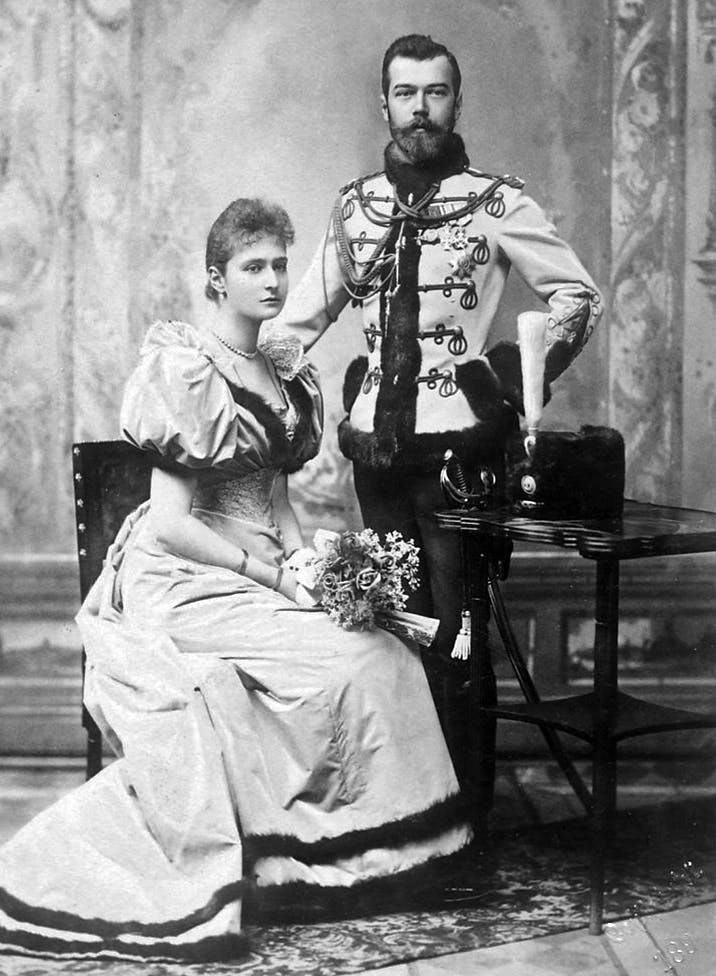
Public domain, via Wikimedia Commons.
Their story’s most famous adaptations are the 1967 book, Nicholas and Alexandra, by historian Robert K. Massie and the 1971 movie of the same name starring Michael Jayston as Nicholas and Janet Suzman as Alexandra. The future Tsar and Tsarina of Russia met and fell in love as teenagers, but neither of their families approved of the match. However, their love persevered, and they got married in 1894. Their love continued through their five children, who were famous for having such a close and loving relationship.
Through the struggle of their son’s hemophilia and the brutality of the Russian Revolution, their love and devotion to each other kept them in love until they were murdered alongside their children in 1918. (The death of their daughter Maria also ended another historical love story.)
Closing Thoughts
We often rely on fiction for healthy escapism, making historical romances (both factual and fictional) the stories we turn to for an escape to a bygone era. From books about Imperial Russia, TV shows about Renaissance England, and movies about Ancient Egypt, historical romances often bring a little more love and beauty into our imaginations.